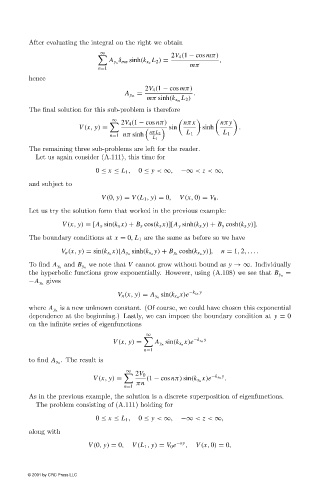Page 499 - Electromagnetics
P. 499
After evaluating the integral on the right we obtain
∞
2V 4 (1 − cos mπ)
δ L 2 ) = ,
A y n mn sinh(k x n
mπ
n=1
hence
2V 4 (1 − cos mπ)
= .
A y m
L 2 )
mπ sinh(k x m
The final solution for this sub-problem is therefore
∞
2V 4 (1 − cos nπ) nπx nπy
V (x, y) = sin sinh .
n=1 nπ sinh nπ L 2 L 1 L 1
L 1
The remaining three sub-problems are left for the reader.
Let us again consider (A.111), this time for
0 ≤ x ≤ L 1 , 0 ≤ y < ∞, −∞ < z < ∞,
and subject to
V (0, y) = V (L 1 , y) = 0, V (x, 0) = V 0 .
Let us try the solution form that worked in the previous example:
V (x, y) = [A x sin(k x x) + B x cos(k x x)][A y sinh(k x y) + B y cosh(k x y)].
The boundary conditions at x = 0, L 1 are the same as before so we have
y)], n = 1, 2,....
V n (x, y) = sin(k x n x)[A y n sinh(k x n y) + B y n cosh(k x n
we note that V cannot grow without bound as y →∞. Individually
To find A y n and B y n
=
the hyperbolic functions grow exponentially. However, using (A.108) we see that B y n
gives
−A y n
x)e −k x n y
V n (x, y) = A y n sin(k x n
is a new unknown constant. (Of course, we could have chosen this exponential
where A y n
dependence at the beginning.) Lastly, we can impose the boundary condition at y = 0
on the infinite series of eigenfunctions
∞
−k x n y
V (x, y) = A y n sin(k x n x)e
n=1
. The result is
to find A y n
∞
2V 0 −k x n y
V (x, y) = (1 − cos nπ) sin(k x n x)e .
πn
n=1
As in the previous example, the solution is a discrete superposition of eigenfunctions.
The problem consisting of (A.111) holding for
0 ≤ x ≤ L 1 , 0 ≤ y < ∞, −∞ < z < ∞,
along with
V (0, y) = 0, V (L 1 , y) = V 0 e −ay , V (x, 0) = 0,
© 2001 by CRC Press LLC

